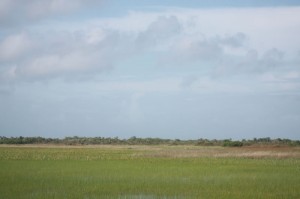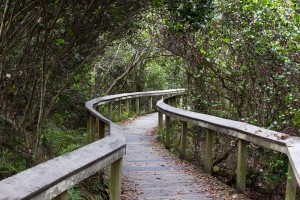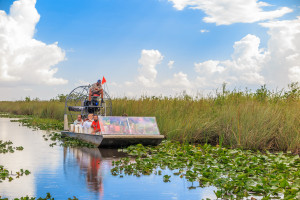 The rest of us may have four seasons (Spring, Summer, Fall, and Winter), but did you know the Everglades only has two seasons? The Everglades seasons don’t go by the temperature, but rather the water levels in the wetland. The two seasons are known as: the Wet Season and the Dry Season.
The rest of us may have four seasons (Spring, Summer, Fall, and Winter), but did you know the Everglades only has two seasons? The Everglades seasons don’t go by the temperature, but rather the water levels in the wetland. The two seasons are known as: the Wet Season and the Dry Season.
The Everglades’ wet seasons runs from April to November. During this time, the area experience intense storms and rains. The Everglades gets about 60 inches of rain per year. The Dry Season begins in November and ends in April. There is little rain during the dry season, usually only around a quarter of the yearly rainfall occurs during the dry season.
The Everglades’ water levels aren’t just determined by the rainfall in the Everglades, but in other parts of the state of Florida, as well. Why? Well, there are so many different bodies of water that flow into the Everglades. Rain in Central Florida makes its way down into Lake Okeechobee and Florida Bay, which lead into the Everglades.
Since humans have disrupted the natural flow of water in the Everglades (water has been diverted), animal and plant life populations have changed and declined. Naturally, the water levels in the Everglades change month to month, but the animal life and plant life that are native to the area are accustomed to these water changes. In fact, they expect and depend on the water levels to change.
For example, some birds will only nest if the water level is at a certain height; if it’s not, the birds will be hesitant to settle down to nest. There are many reasons birds fly to the Everglades during the winter. Since it’s the dry season in Florida, it’s not only warmer than the North, but the dry weather makes it easier for the birds and their offspring to find food. Birds, like the Wood Stork and Anhinga breed, need shallow water to find fish and other food sources faster and easier. When the water levels change, the birds will start to look for other places to nest or won’t breed at all.
The ecosystem of the Everglades is delicate. It requires an ideal balance for the animals and plants to be happy and thrive. Unfortunately, humans, storms, climate change, and invasive species can wreak havoc on this balance. If there is too little or too much water in the Everglades, animals will move elsewhere, plants will die off and slowly more and more negative changes will begin to snowball. This water affects breeding, drinking, growing, and provides homes and shelters.
The water in the Everglades even affects humans’ drinking water. As water flows into the Everglades, it gets soaked into the limestone underground and gets stored into aquifers (caves). Aquifers are fresh water sources. The Biscayne Aquifer provides the clean drinking water for southeast Florida.
A proper balance of water is essential in the Everglades, as well as the water’s timing and quality and where it ends up.
If you’d like to get a chance to fly through some of the Everglades’ waterways, book a trip on an airboat with Captain Mitch’s Airboat Tours. Click here or call 800-368-0065 to book an airboat tour adventure today.
 One of the biggest threats to a balanced ecosystem in the Everglades is the Burmese pythons. These snakes are an invasive species in the wetland. The python happens to love the Everglades, but this wetland cannot handle its presence. Pythons prey on almost anything in their path, and have been known to cause a large depletion in the rabbit, opossum, wading birds, racoons and other small populations population in the area. Its only predators are the American alligator and the Florida panther. However, these pythons can put up a fight and a recent video take by someone in the Everglades showed an alligator losing a fight with a python in water.
One of the biggest threats to a balanced ecosystem in the Everglades is the Burmese pythons. These snakes are an invasive species in the wetland. The python happens to love the Everglades, but this wetland cannot handle its presence. Pythons prey on almost anything in their path, and have been known to cause a large depletion in the rabbit, opossum, wading birds, racoons and other small populations population in the area. Its only predators are the American alligator and the Florida panther. However, these pythons can put up a fight and a recent video take by someone in the Everglades showed an alligator losing a fight with a python in water. Ever heard of the gumbo-limbo tree? No, it’s not from a fantasy book, it’s a real tree that lives in the Everglades. In fact, it’s one of the best-known trees in south Florida. It’s also known as the “tourist tree,” because its peeling bark resembles the skin of South Florida visitors.
Ever heard of the gumbo-limbo tree? No, it’s not from a fantasy book, it’s a real tree that lives in the Everglades. In fact, it’s one of the best-known trees in south Florida. It’s also known as the “tourist tree,” because its peeling bark resembles the skin of South Florida visitors. Not only is the Everglades a beautiful landscape to explore, you also can get a history lesson while in the Park. In the park, the Nike Hercules Missile site stands, and it happens to be a relic of The Cold War. Visitors are able to visit the Nike Missile Base by a ranger-guided walk that is offered in the months of December through April. The site is home to 22 buildings and structures.
Not only is the Everglades a beautiful landscape to explore, you also can get a history lesson while in the Park. In the park, the Nike Hercules Missile site stands, and it happens to be a relic of The Cold War. Visitors are able to visit the Nike Missile Base by a ranger-guided walk that is offered in the months of December through April. The site is home to 22 buildings and structures. Did you know a Native American tribe resides still in the Everglades? There is, and they are called the Miccosukee Tribe of Indians of Florida. They occupy several reservations in Florida, known as the Miccosukee Indian Reservation The largest section of this reservation is 333 acres of the north border of the Everglades National Park; in fact, the tribe controls around 200,000 acres of wetland; this land must be used for “the purpose of hunting, fishing, frogging, and subsistence agriculture to carry on the traditional Miccosukee way of life.”
Did you know a Native American tribe resides still in the Everglades? There is, and they are called the Miccosukee Tribe of Indians of Florida. They occupy several reservations in Florida, known as the Miccosukee Indian Reservation The largest section of this reservation is 333 acres of the north border of the Everglades National Park; in fact, the tribe controls around 200,000 acres of wetland; this land must be used for “the purpose of hunting, fishing, frogging, and subsistence agriculture to carry on the traditional Miccosukee way of life.” Camping is one of the best ways to experience the great outdoors. But, did you know you can actually go camping in the Everglades National Park? You can! The park offers camping opportunities in both the front country and back country. Visitors are able to go camping year-round, but the wet season (June through November) is a more difficult and uncomfortable environment for camping. If you’re thinking about experiencing this beautiful wetland through a camping experience, remember to come prepared; the park does not provide any camping equipment for people to buy or rent.
Camping is one of the best ways to experience the great outdoors. But, did you know you can actually go camping in the Everglades National Park? You can! The park offers camping opportunities in both the front country and back country. Visitors are able to go camping year-round, but the wet season (June through November) is a more difficult and uncomfortable environment for camping. If you’re thinking about experiencing this beautiful wetland through a camping experience, remember to come prepared; the park does not provide any camping equipment for people to buy or rent. The Everglades is home to an array of plants that thrive in the wet, subtropical climate. Although mangroves and grasses come to many people’s minds when thinking about plant life in the Everglades, we’d like to profile a plant that many people might not know about that is native to the area: the pond apple.
The Everglades is home to an array of plants that thrive in the wet, subtropical climate. Although mangroves and grasses come to many people’s minds when thinking about plant life in the Everglades, we’d like to profile a plant that many people might not know about that is native to the area: the pond apple. The Everglades is a beautifully mysterious place to visit. So, why not experience it up-close-and-personal? The Everglades National Park allows visitors to explore their surroundings with several hiking and bike trails winding throughout the wetlands.
The Everglades is a beautifully mysterious place to visit. So, why not experience it up-close-and-personal? The Everglades National Park allows visitors to explore their surroundings with several hiking and bike trails winding throughout the wetlands. What’s the best way to see the Everglades? There are several options, and each offers a very different experience. Foot soldiers will enjoy the intricate trail systems spread across the Everglades ecosystem. And for water lovers, the adventures are endless. For a workout, pursue a paddle trail. Or for a more relaxed experience, hop on an airboat. Here’s the low down on each Everglades recreational activity.
What’s the best way to see the Everglades? There are several options, and each offers a very different experience. Foot soldiers will enjoy the intricate trail systems spread across the Everglades ecosystem. And for water lovers, the adventures are endless. For a workout, pursue a paddle trail. Or for a more relaxed experience, hop on an airboat. Here’s the low down on each Everglades recreational activity. Did you know Florida is home to over 2,500 bears? The Florida Black Bear, the state’s only resident bear, is Florida’s largest land-based mammal. These gentle giants, ranging from 125-450 pounds, live in seven isolated subpopulations from the Panhandle down to the Everglades.
Did you know Florida is home to over 2,500 bears? The Florida Black Bear, the state’s only resident bear, is Florida’s largest land-based mammal. These gentle giants, ranging from 125-450 pounds, live in seven isolated subpopulations from the Panhandle down to the Everglades.





